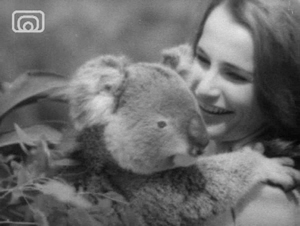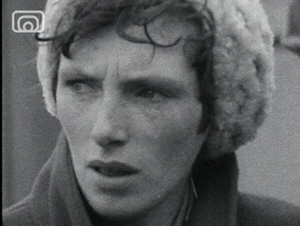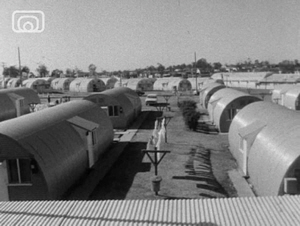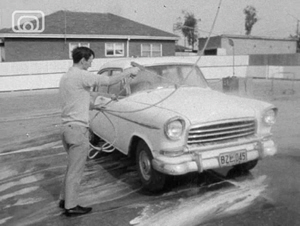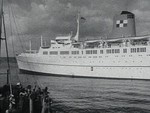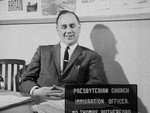Emigration from Scotland in the 1960s
- Introduction
- Lesson
- Film Clips
- Print All
Introduction
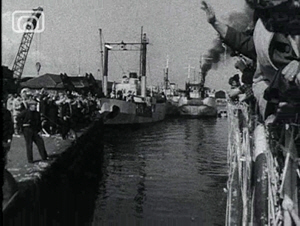
This Lesson Guide is intended for use with Standard Grade pupils studying Changing Life in Scotland in Britain Context C: 1880s to the present day. Some of the films and activities may also be suitable for work with upper primary and junior secondary pupils looking at life in Scotland from the 1930s-1960s.
Lesson
Emigration from Scotland increased in the 1960s as transport to Commonwealth countries such as Canada, Australia and New Zealand became both cheaper and easier than ever before. Many people were attracted by employment opportunities and the possibility of starting a new life abroad. Cheap ship travel was subsidised by the Commonwealth governments, who had a need for new labour and particularly wanted English speaking immigrants. The development of aeroplane travel made opportunities abroad more attractive to those emigrants who might otherwise have been put off by the thought of the long sea journey and the possibility that they might never see relatives and friends at home again. The clips we are to watch show some of the ‘push’ and ‘pull’ factors in 1960s emigration from Scotland, as well as the joys and problems faced by those who emigrated from Scotland.
Clearance '68 (clip 1)Clip 1: ‘Clearance ‘68 clip 1’ (1968)
This clip is 7.14 minutes long
Questions:
- How many Scots were leaving Scotland every day in 1968? How many of them were likely to come back?
- Which countries were they likely to go to?
- How many Scots emigrated to Canada in 1967?
- What concerns did the family wanting to emigrate to Canada have?
- What reasons do the people in the airport give for going abroad?
- What worries and problems do they have?
Clip 2: ‘So many partings clip 1’(1966)
This clip is 8.32 minutes long
Questions:
- Describe the opening scene by the ship. What do you think the people are feeling?
- What expectations do they have of the countries where they’ll be going?
- What impact do you think emigration had on the people and communities left behind?
Clip 3: ‘Will ye no come back?’ Clip 1 (1968)
This clip is 11.04 minutes long.
Questions:
- The opening sequence shows buildings in Australia with a Scots influence. What point do you think the film maker is trying to make by showing these?
- What does Janette mean when she says she wanted to ‘better herself’ by coming to Australia? Does she feel she has been able to do so?
- Why did William Findlay come to Australia? How has he found it?
- Describe the Findlay’s experience when they first got to Australia. What kind of housing did they get and what kind of work did they do?
- What kind of business did William Findlay set up and how did he do it? How successful has he been?
- Describe the differences between the life of the Findlay’s children and his own childhood.
- Describe Janette and Tom’s experience on getting to Australia. What problems did Tom have in getting to work?
- What are the conditions like in the camps where they stay? Describe the ‘Nissan hut’.
- What does Tom like about Australia?
- Why do you think the Findlays have been more successful in Australia than the other family?
Clip 4 – ‘Will ye no come back again?’ clip 3 (1968)
This clip is 10.04 minutes long.
Questions:
- Describe the kinds of events being put on by the Scottish societies? Have you ever been to any events like these?
- What kinds of things do the people in the film miss most about Scotland?
- What advice does Mr Findlay give to young couples wanting to emigrate to Australia?
- Do you think that, overall, the film paints a positive or negative picture of life in Australia? Explain your answer.
Activities
- In groups, imagine that you are the Australian Tourist Board in the 1960s. Develop a 5 min presentation aimed at potential emigrants to Australia. The presentation should describe the reasons for people to emigrate, how they would go about doing this and what they can expect when they get there. Your group may use PowerPoint, flip charts, posters, or any other medium to enhance their presentation.
- Imagine you have just boarded a ship with your parents, bound for Canada or Australia in the 1960s. Write a diary entry for your first night on the ship, outlining your worries and hopes about emigrating. Your diary entry should be at least 1 page long.
- Family research task. Research your family history to find out if anyone you are related to emigrated to Canada or Australia, or was an emigrant to Britain. Find out why they emigrated and how they found life in their new country. Were they more successful in the new country than they had been in the old? What problems did they encounter? Were they able to go back and visit family and friends? In groups of 4-5, create posters showing stories about emigration within your families for display within the classroom. These should include photos and timelines where possible.
- Drama task. One of the women in ‘Will ye no come back again’ clip 3 comments on how she is worried that she’ll get homesick after she goes home to visit. In groups, produce a short 5-10 minute long drama about her first visit back to her family back home. What do you think they will ask her about Australia? What will she tell them? The drama should give an overall impression of how she has found her experience in Australia and how her departure has affected her family back home.
Lesson guide developed by Olivia Drennan.
